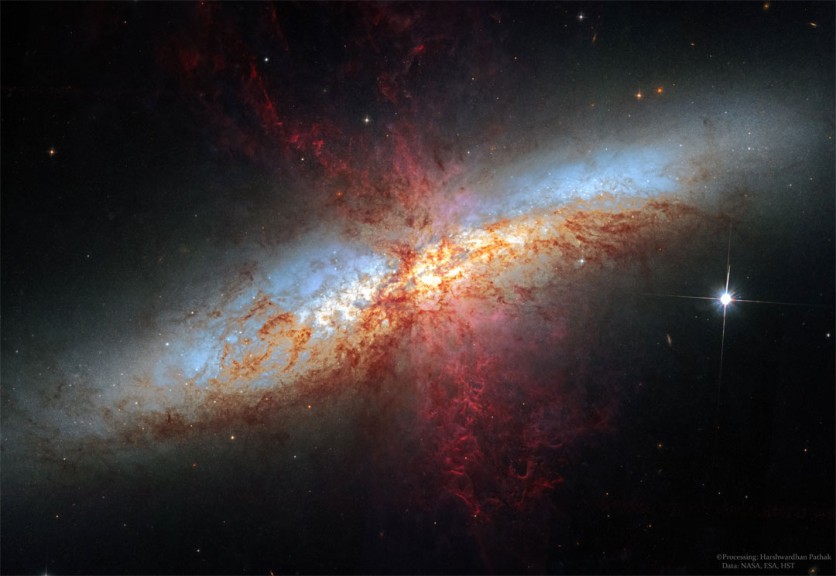NASA's Hubble Space Telescope has captured a stunning image of the Cigar Galaxy, also known as M82, billowing red smoke into space.
While this starburst galaxy's recent close encounter with the large spiral galaxy M81 may have stirred it up, the true source of the red-glowing gas and dust remains a mystery.

Supergalactic Wind
The mesmerizing photograph showcases the Cigar Galaxy, M82, with its distinctive supergalactic wind. The outwardly expanding gas and dust are believed to be driven out by the combined forces of emerging particle winds from numerous stars, creating what scientists call a galactic superwind.
The particles of dust in this phenomenon are thought to originate from M82's interstellar medium and are remarkably similar in size to those found in cigar smoke.
The image, processed and copyrighted by Harshwardhan Pathak, focuses on a specific hue of red light emitted by ionized hydrogen gas, revealing intricate filaments of gas and dust. These filaments are extensive, stretching for over 10,000 light-years within the galaxy.
The Cigar Galaxy lies approximately 12 million light-years away from Earth and is renowned for being the brightest galaxy in the infrared spectrum. Even with a small telescope, it can be observed in visible light toward the constellation of the Great Bear, also known as Ursa Major.
M82 is classified as a starburst galaxy, which means it has an exceptionally high rate of star formation. This intense star formation is caused by interactions and gravitational interactions with its neighboring galaxy, M81, which is also in the same region of the sky.
The gravitational forces between these two galaxies have led to the compression of gas and dust in M82, resulting in the formation of new stars at a rapid pace.
Read Also : NASA Hubble Discovers Saturn's Ring System Heats Planet's Atmosphere-A Never-Before-Seen Phenomenon!
Bright Infrared Emission
The galaxy is also believed to have an active galactic nucleus (AGN), which is thought to be powered by a supermassive black hole at its center. This AGN produces significant amounts of energy across the electromagnetic spectrum, including X-rays and radio waves.
Because of its brightness and distinctive appearance, M82 is a favorite target for amateur astronomers and astrophotographers. Its location in the northern hemisphere and relative proximity to Earth makes it easily observable with telescopes and even binoculars under dark skies.
Due to its relatively bright infrared emission, M82 is considered one of the brightest galaxies in the sky when observed in infrared wavelengths. Additionally, amateur astronomers with small telescopes can also spot it in visible light towards the constellation of Ursa Major.
The study of M82 and its superwind provides astronomers with valuable data and insights into the mechanisms driving star formation, galaxy interactions, and the complex processes shaping the universe we inhabit. Its proximity and remarkable activity make M82 a fascinating subject.
Related Article : NASA's Hubble Space Telescope Captures 'Butterfly Nebula' In Stunning Motion | Fun Facts About This Beautiful Space Butterfly

ⓒ 2025 TECHTIMES.com All rights reserved. Do not reproduce without permission.




